June E. Chatfield BSc (Special) PhD ARCS FBNA
Based on a presentation to the BCG Symposium at the Open University, Milton Keynes March 2009
In making a specialist study, attention is focussed on a narrow range of species, sometimes from a limited geographical area, a specific habitat or from a human perspective in that sliver of time – the present day. It can be useful to take a big step back and reflect on the larger picture when we look for patterns in the data: looking backwards in order to go forwards.
Children can have difficulty with the concept of time, especially before the development of formal or abstract thought, but prehistoric extinct giant reptiles really engage them. Dinosaurs are big industry. A neighbour of mine who was a primary school teacher and nearing retirement, so therefore ‘old’ in a child’s view of things, had a pupil in her class coming up to her after one of her lessons and asking:
"Mrs Hawkins, when you were very, very young ......do you remember seeing dinosaurs?"
Rather a long shot in the late twentieth century as the fifth mass extinction at the end of the Cretaceous Period about 65 million years ago had seen them off.
The concept of time and fossil history is a topical one in 2009, a year that marks the bicentenary of Charles Darwin’s birth in 1809 and the 150th anniversary of the publication of his famous book On the Origin of Species in 1859. Variation in giant tortoises on the different islands of the Galapagos archipelago was pointed out to Darwin by Nicholas Lawson, then acting as Governor on the island of Floreana, who told Darwin that he could tell which island a tortoise came from by its shell shape (Darwin, 1890; Keynes 2002). However, although Darwin’s descriptions of the giant tortoises on the Galapagos islands in his account of the voyage of HMS Beagle have attracted much attention, he did not at the time see the relevance of this to his theory and in his short visits to the islands between mid-September and mid-October 1835 he may not have seen all the varieties of tortoise himself. Darwin did not collect specimens of giant tortoises for scientific study. The HMS Beagle, however, took on board 48 tortoises for meat on the return journey while Charles Darwin and Syms Covington took two small ones back as pets. The value of the giant tortoises as a meat supply for mariners had long been established and at one time it was possible to take 200 tortoises in a day. By the time of the Beagle voyage numbers of tortoises were much depleted but they were still being taken for food and were salted for storage at sea. Darwin’s report of tortoise as food was:
The Breast-plate with the meat attached to it is roasted as the Gauchos do the ‘Carne con cuero’ (meat on the hide). It is then very good. Young tortoises make capital soup – otherwise the meat is, to my taste, but indifferent food.
Some further quotations from Darwin on tortoises were given in an earlier article in Testudo (Chatfield, 1987).
Darwin, after completing his arts degree and spending some time at Cambridge preparing for ordination and accompanying Professor Adam Sedgwick to assist in geological fieldwork in Wales, was invited in 1831 to join HMS Beagle, a survey ship where his original role was as a geologist and gentleman companion to Captain FitzRoy. In those days geology was an infant discipline with the Geological Society only founded in 1807. Nearly everyone believed the Biblical story of the Creation in Genesis, verbatim rather than as metaphor, and the age of the Earth was believed to be a matter of a few thousand years old, not even enough to take us back to the comparatively recent Ice Ages of the Pleistocene (1.8 million years to 10,000 years ago). Fossils were still difficult to fathom out. On the Beagle voyage, during his land expeditions, Darwin discovered fossil bones of extinct species of giant mammals while fossil seashells were found in rocks on tops of mountains, so he began speculating on a greater age for the Earth, vast changes in its history and gradual adaptation and change in animals that led him eventually to his theory of natural selection that directed the change. During the Beagle voyage he wrote many more pages of notes on geology than he did on natural history, the subject for which Darwin is more generally known. He consolidated his knowledge by taking Charles Lyell’s book Principles of Geology with him and applying it in the field. On the Beagle, Darwin was an unpaid supernumerary but his geological skills were useful to FitzRoy in survey work, and being a gentleman and not part of the crew he was able to be a companion to the Captain and relieve the loneliness of command. On the previous voyage of the Beagle, the original Captain had committed suicide and FitzRoy was taken on board as the new Captain when they docked at Rio de Janeiro. There had been mental illness in FitzRoy’s family and indeed his death over 30 years later, in 1865, was by his own hand.
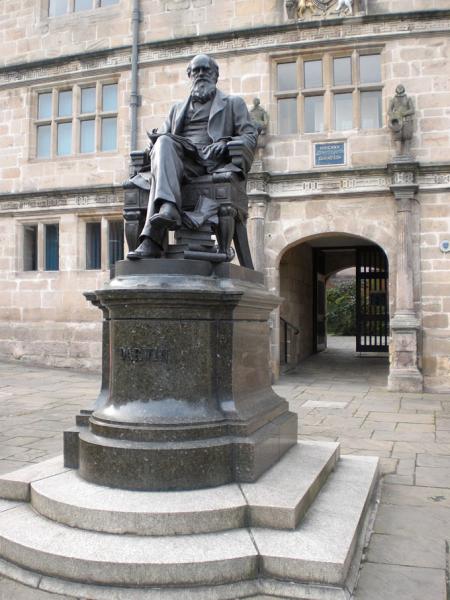
Fig. 1. Statue of Charles Darwin outside his old school in Shrewsbury, now the town library. Photos by June Chatfield.
Although Darwin investigated species in great detail (especially his beloved beetles) from his childhood in Shrewsbury on the Welsh borderland, he also explored the countryside and developed a broad interest in natural history from first-hand experience. He was no great scholar at the time and his father, Dr Robert Darwin, thought that he would be a disgrace to the family. Charles was sent to Edinburgh to study medicine with his older brother Erasmus and there he met fellow naturalists, joined a society and went exploring the shore life of the Scottish east coast with Robert Grant (after whom the sponge Grantia is named). He gave rather more effort to investigating natural history than he gave to studying medicine, a course that he did not finish. Having given up on Charles becoming a doctor like himself, his father then sent him to Cambridge to take an arts degree to be followed by ordination and a life as a country parson. He obtained his BA (but without Honours) and stayed on to prepare for ordination. At Cambridge he also followed his interests in natural history, and beetles in particular, with his cousin William Darwin Fox who was also there. Darwin attended The Reverend John Stevens Henslow’s lectures on botany and joined him in the field collecting plants: this proved to be useful experience for the future. Studying for ordination somehow never happened, as his time with the Reverend Henslow was taken up with talking botany and with the Reverend Leonard Jenyns in discussing their common interest in beetles. During the summer vacation Charles Darwin went to north Wales to assist Professor Sedgwick of Cambridge with some geological survey work: this was to prove even more useful experience for his later exploits. Awaiting him on his return to Shrewsbury was a letter from Henslow inviting Darwin to take up an invitation from Captain Fitzroy to join a survey ship HMS Beagle that would be departing for a voyage round the world later that year. Henslow had originally been invited, but his wife was far from enthusiastic, so the chance was given to the young graduate, Charles Darwin. In the short autobiography, written for his children, Darwin describes the Beagle voyage as the most important event in his life. The autobiography was published posthumously by his son Francis (Darwin, 1929) who added further recollections.
The big picture
In recent years, within our own lifetime, great advances have been made in understanding the universe, solar system, Earth and the story of life. It is all very humbling how small a part in the scheme of things we are, whizzing around space with very limited control of our destiny. The Earth will one day be engulfed by the Sun, for example, as the Sun goes through its evolution as a star into a red giant, before becoming a white dwarf (Catchpole, No date), and before then another large approaching asteroid, such as one whose landing 65 million years ago is now thought to have caused the fifth great extinction event, may be a hit rather than a near miss. Near Earth Objects are now being actively surveyed as a matter of concern: there is a display on these in the Earth Sciences galleries at the Natural History Museum in London.
Technology, coupled with intellectual thought, have given us a greater understanding of the world than Darwin ever had, also indicating much that we still do not know. Scientists observe things, do experiments, undertake analysis and using the existing data, come up with an interpretation of how it all works and the significance of the knowledge. But in many things our conclusions are only as good as the data and there are many gaps in the data sets, as in fossil evidence. We are trying to do a jumble sale jigsaw puzzle with a lot of pieces missing! The animals that we find preserved in the rocks as fossils are only a small sample of the total contemporary fauna and may not even be representative. Ideas have to change when new pieces of information become available. This is why palaeontology has been rather exciting in the last 20 years.
In the nineteenth century the main Eras and Periods of geological time in sedimentary rocks, often identified by the species they contained (known as zone fossils) were set out and mapped. There was a major distinction between the sedimentary rocks that contained fossils (the Phanerozoic) and those older ones that did not. The Phanerozoic began with the Cambrian Period, now dated about 570 million years ago. For about three billion years before that we now conclude that there was life on Earth and it developed very slowly from microscopic bacterial-type organisms (without their genetic material contained in nuclei), to eukaryotes (single cells with nuclei containing their DNA), while more complex, multicellular organisms did not get going until just before the Phanerozoic (e.g. the Ediacaran fauna of Australia). Environmental change seems to have been the driver for new forms of life. New species and groups often occur after major extinction events that marked the end of the Ordovician, Devonian, Permian, Triassic and Cretaceous Periods. Vertebrate life (with chelonia or testudines), as we know it, depends on oxygen for respiration and there is currently about 21% oxygen in the atmosphere. It took until the Phanerozoic for it to build up to only 2-3%. The first photosynthesising organisms giving off oxygen as a waste product were stromatolites, colonies of blue-green bacteria (once called algae). There are models of these in the Evolution House at Kew Gardens.
Another obstacle to modern life, that had to wait for a solution, was ultra-violet radiation (a problem that has re-emerged with recent holes in the ozone layer) and it was not until there was a protective layer in the atmosphere that life could advance, and with this, phytoplankton (microscopic green organisms) living at the surface of the sea became possible, further enriching the oxygen in the atmosphere to about 17% and providing the base of a food chain for marine animal life. All the major invertebrate animal Phyla had appeared in some form in the Cambrian. Most of the action was in the sea as the land was inhospitable to life with the volcanic activity and noxious gases at that time and, even then, there were frequent extinction events in marine animals during the Cambrian and the first major extinction event at the junction of the Ordovician and Silurian Periods. It was no suitable place for tortoises or any other land animal. This is demonstrated in the time line display in the Geology Gallery at Haslemere Educational Museum in Surrey.
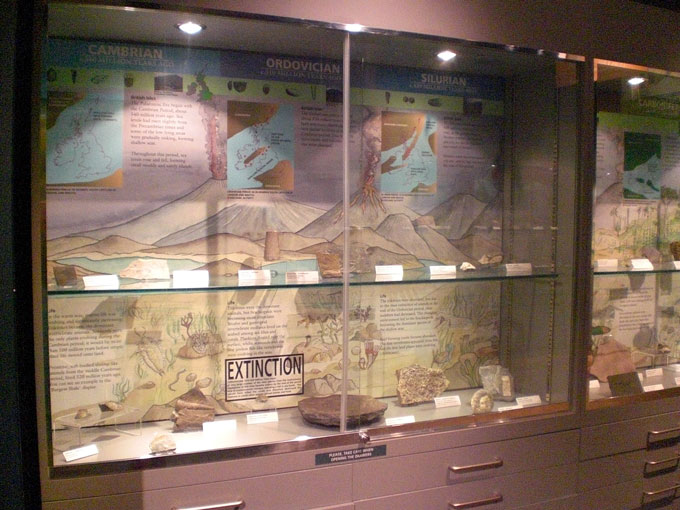
Fig. 2. The time line display at Haslemere Educational Museum showing the early part of life on Earth.
The Devonian Period that followed was the Age of Fishes. Many of them were armour-plated suggesting the dangers of predators and carnivorous life-styles. Changes in environmental conditions as a result of the falling of sea levels gave animals that could scramble from pool to pool (evolution of the tetrapods with four limbs) an advantage and, with more oxygen in the atmosphere and ozone giving better atmospheric protection from radiation, opportunities then existed on land for vertebrates to escape aquatic predators. There was also the possibility of finding arthropods to eat, and so the way was clear for the evolution of amphibians and reptiles. Plant life of larger form also started to colonise the land and so it became a viable environment for animals to live.
The reptiles had the winning ticket in conquering the land with their shelled eggs that could be laid in the ground and thick horny skin preventing body water-loss and mechanical damage. Chelonia or testudines, with their short squat bodies and protective shell, involving both bony and horny elements, first come into fossil evidence in the late Triassic about 200 million years ago when life on land was rather dry. Various other physiological adaptations relating to excretion with minimal water-loss, gave reptiles a functional advantage in these conditions. Penetrative internal fertilisation and shelled eggs that were laid in burrows in the ground gave the reptiles further advantages over amphibians (frogs and toads) that still depended on external fertilisation and aquatic conditions for egg laying and development of the tadpole stage.
Mass extinction events
Extinction rates were very high in early Palaeozoic times, and then at the end of the Permian, 250 million years ago, the third major and worst extinction event of all time took place when, according to the fossil evidence, 90-95% of species died out while some complete families and larger groups disappeared. This was the subject of Michael Benton’s recent book (2008) When Life Nearly Died. Recovery of species (but different ones) took about 50 million years after this event compared with 20-30 million years of lesser mass extinctions. When niches become vacant due to extinctions, there is opportunity and chelonia or testudines came into the story during the recovery after this great Permian extinction. The group as a whole survived both the following fourth mass extinction of the late Triassic (195 million years ago) and the fifth mass extinction at the end of the Cretaceous (65 million years ago), the one that saw the end of their fellow reptiles, the dinosaurs.
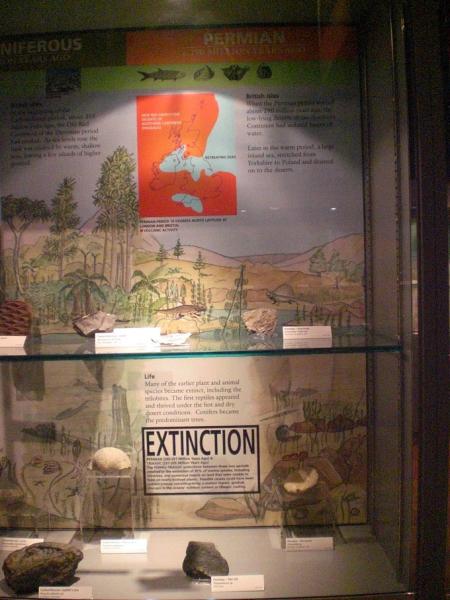
Fig. 3. The time line display at Haslemere Educational Museum showing the late Permian mass extinction.
Richard Leakey’s book (1995) The Sixth Extinction discusses the impact of humans on the environment. Rates of species extinctions have accelerated since the middle of the twentieth century and, unlike other extinction events, the cause is attributed to biological causes in the form of human activity affecting them locally by habitat destruction as well as globally by a human-induced contribution to climate change. The species most at risk are island faunas, those of narrow-range habitat and limited geographical range. It does not pay to be environmentally fussy or isolated in threatening conditions.
Although radiating into land, freshwater and marine environments, chelonia have not changed their basic design a great deal. As animals they tend to keep a low profile, have a protective shell effective against many predators, and often burrow into the ground for dormant periods when conditions are unfavourable. This can be during drought as in the Australian river turtles or in winter for hibernation in cooler temperate climates as in land tortoises and terrapins. They have so far been great survivors.
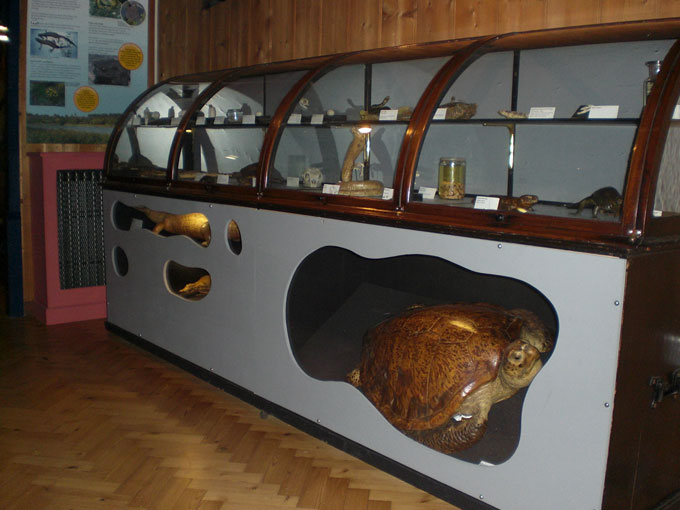
Fig. 4. Display of modern reptiles in the Natural History Gallery at Haslemere Educational Museum.
Environmental change
Throughout the 570 million years of the Phanerozoic the oxygen content of the air has changed from an early meagre 1-3% to an all-time high of 35% in the time of the forests of tree ferns, tree horsetails and tree club mosses in the Carboniferous Period that laid down our supplies of coal, a time before chelonians came into being. Carbon dioxide levels have similarly fluctuated, dropping when a rich flora absorbs carbon dioxide for photosynthesis, hence our current interest in growing more trees to help combat greenhouse gases.
Temperature and humidity have also changed substantially and there have been previous glaciations or ice ages in the Pre-Cambrian and the Permian Periods as well as our more recent Ice Ages of the Quaternary. Sea levels have risen and fallen and the polarity of magnetism has reversed. All of these are reflected in the fossils preserved at the time.
The fossil lottery
A fossil is the buried remains of the body or a stone replica from a cast when a silt or mineral deposit comes in to fill the gap where a body structure has dissolved away or where the hard parts of shell and bone are later impregnated with mineral salts draining through the rocks. Trace fossils are preserved footprints, an extremely chance event as footprints are transient, usually being weathered away rather than preserved.
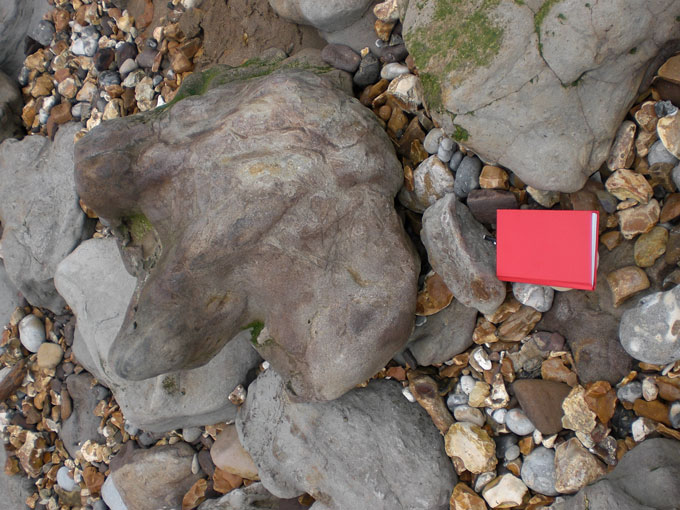
Fig. 5. Cast of a dinosaur footprint at Hanover Point, Isle of Wight, with field notebook 15x10cms for scale.
Looking through museum collections and papers on palaeontology it is apparent that fossil reptiles are relatively rare, especially intact individuals as compared with scattered pieces. Land animals have a lower chance of being preserved as a fossil than aquatic ones, unless they fall into a swamp. First the body needs to escape being eaten and dismembered; it needs to be buried quickly to avoid decomposition (of ligaments holding the bones together) and fragmentation: these conditions are more likely to be met in aquatic environments than on land. Fossil evidence is not always representative of the species that lived at the time as some animals preserve better than others.
In Haslemere Educational Museum in Surrey we have a time-line display, but no fossil chelonian. At Dinosaur Isle, the new museum at Sandown on the Isle of Wight, there are just two chelonians on display, the largest being a soft-shell turtle Trionyx found in the Tertiary deposits about 35 million years old. The northern half of the Isle of Wight has an exceptionally good series of Tertiary strata. I have also found isolated turtle plates in the Barton Beds of similar age on the Solent shore of Hampshire, east of Bournemouth, following land slips in 1966. These would have been freshwater or marine turtles of a subtropical climate.
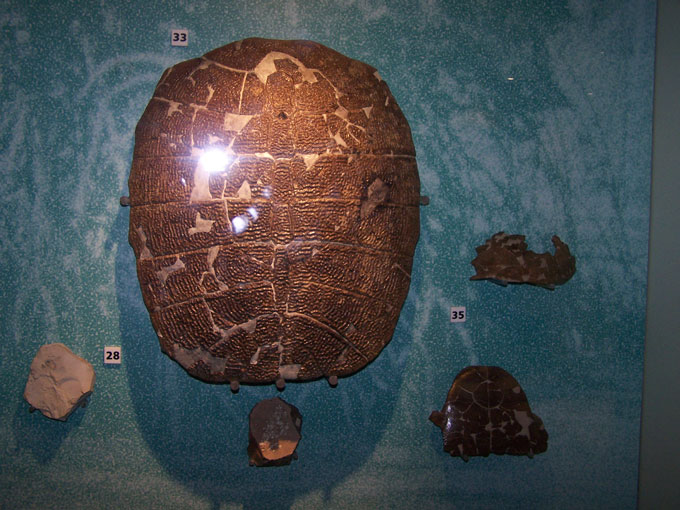
Fig. 6. Carapace of the soft-shell turtle Trionyx incrassatus (33 left) and pond turtle Emys sp. (35 right) both from Fishbourne, Isle of Wight. Dinosaur Isle, Sandown.
The future
There will continue to be extinctions and some will be hastened through the activities of Man, particularly involving habitat destruction. A certain number of extinctions are natural and give opportunities for new species to evolve and take over the niche. Change often conquers adverse environmental conditions with the non-adaptor going under. Natural environmental changes will continue and who knows when the next asteroid will hit us, repeating the events at the end of the Cretaceous but on a different suite of species. However, evidence is building up against humans, as a species, in adding to environmental change at both a local level of habitat destruction and broader based climate change. Lee Durrell’s talk at an earlier BCG Symposium in 1994, published in Testudo, addresses the position from the point of view of practical conservation work by the Jersey Wildlife Protection Trust.
Acknowledgements
I am grateful to the Curator of the Haslemere Educational Museum, Julia Tanner and the Curator of Dinosaur Isle, Sandown, Isle of Wight, for their permission to use photographs taken of museum displays.
References
Benton, M. (1997). Vertebrate Palaeontology, Chapman and Hall, London.
Benton, M. (2008). When Life Nearly Died. Thames and Hudson, London.
Catchpole, R.M. (ND). Stellar Evolution. The Life and Death of Stars. Royal Observatory Greenwich.
Chatfield, J. (1987). Charles Darwin’s Account of Giant Tortoises on the Galapagos Islands. Testudo 2(5): 55-62.
Darwin, C. (1890). Journal of Researches into the Natural History and Geology of the Countries Visited during the Voyage of HMS Beagle Round the World. (From corrected and enlarged edition of 1845). Ward, Lock and Co., London, New York and Melbourne.
Darwin, C. Edited Darwin, F. (1929). Autobiography of Charles Darwin with two Appendices. The Thinker’s Library No. 7, Watts and Co., London.
Darwin, C. (1859). The Origin of Species. Murray, London.
Durrell, L. (1994). A is for Angonoka: The Ploughshare Tortoise Project and the ABCs of Species Conservation. Testudo 4(1): 10-16.
Keynes, R. (2002). Fossils, Finches and Fuegians. Charles Darwin’s Adventures and Discoveries on the Beagle, 1832-1836. Harper Collins, London.
Leakey, R. & Lewin, R. (1995). The Sixth Extinction. Weidenfeld and Nicolson.
Lyell, C. (1997). (Originally 1830-1833). Principles of Geology. Penguin, London.
Palmer, D. (2000). The Atlas of the Prehistoric World. Marshall Publishing Ltd, London.
Wilson, E.O. (1992). The Diversity of Life. Penguin, London.
Testudo Volume Seven Number One 2009
Top






